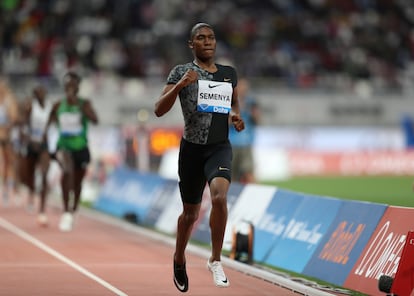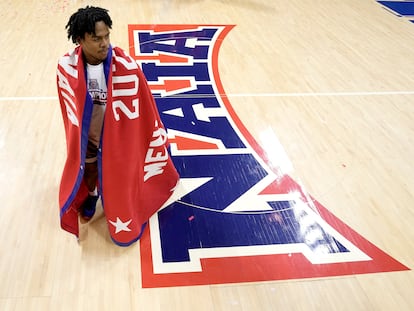Amid an anti-trans wave, World Athletics considers genetic test for athletes competing in the female category
The body chaired by Sebastian Coe unifies the criteria to completely exclude transsexual athletes and women with XY chromosomes and differences in sexual development from competitions

Only women whose biological sex is female and those whose biological sex is male (with XY chromosomes), but who are completely insensitive to the androgenic effects of testosterone (that is, with a female phenotype and even if there is the presence of male gonads), will be able to participate in elite competitions in the female category if World Athletics succeeds in approving, as planned, a new rule next March. To determine their eligibility, and obtain their visa, all athletes considered to be at an elite level — the best in the world, those who qualify for the Olympic Games, World Championships, continental championships or the Diamond League — must undergo a genetic test of saliva or dried blood to determine the presence of the SRY gene, associated with the Y chromosome, which marks the male biological sex, their testosterone levels and whether their body is sensitive to the androgenic and anabolic effects of the hormone of masculinity.
World Athletics (WA), formerly the International Association of Athletics Federations (IAAF), chaired by Sebastian Coe, has submitted these rules to the athletics world for consultation, which will equally affect trans women and those considered XY DSD — people who are assigned the legal sex of woman at birth or who have a female gender identity, despite having fully functioning internal testicles instead of ovaries — two different groups that have been treated unequally until now. Today, before the approval of this new rule, only trans women who have made their transition from hormonal suppression before puberty or 12 years of age and who continuously maintain their serum testosterone concentration below 2.5 nanomoles per liter are allowed to compete; however, DSD women who reduce their testosterone level at any age are allowed to compete. One well-known case is that of South African athlete Caster Semenya, a DSD woman and double Olympic 800m champion, who stopped competing after refusing to take medication to lower her testosterone. Under the new, much stricter rules, testosterone levels and the age of transition will not be taken into account, only genes and sensitivity to testosterone.
The new regulations, if they survive the consultation period, will probably be approved at the next meeting of the World Athletics Council at the end of March. A few days earlier, on March 20, the election of the new president of the International Olympic Committee (IOC) will take place in Greece, a position that Coe is aspiring to. While the current IOC president, Thomas Bach, has handled the issue of trans athletes with a certain amount of caution, Coe and the other candidates have maintained a more intransigent attitude in what they define as the defense of the female category. In addition, just a week ago, Donald Trump signed an executive order prohibiting trans women from participating in women’s competitions in any sport in the United States, where Los Angeles will host the Olympic Games in 2028.
“There is no new countervailing evidence that would suggest that transgender women and androgen sensitive XY DSD athletes are biologically different to each other in relation to the design and goals of the female category,” the group of experts that developed the recommendations said in their consultation document. “New evidence has clarified that testosterone suppression in 46XY DSD and 46XY transgender individuals can only ever partly mitigate the overall male advantage in the sport of athletics.”
Other research the task force relies on indicates that even before puberty — the age when testosterone levels rise in boys and remain low in girls — there are already differences in athletic ability greater than 3% between the sexes in favor of the male. “Exposure to testosterone during male puberty results in sex differences in height, wingspan, pelvic and lower limb architecture (the quadriceps angle — i.e. how the thigh muscles align with the knee),” the paper states. “It was recognised that these body differences provide XY athletes with an advantage, especially in certain events, and that the differences do not respond to suppression of blood testosterone levels in XY athletes after puberty.”
With the SRY gene test, World Athletics is tackling the traditional difficulty of determining biological sex through external genitalia or chromosomes. The penis and clitoris exist on a length spectrum, and the labia may be fused or the scrotum divided, leading to ambiguity when determining sex at birth. Chromosomes carry the recipe for genitalia — XX codes for a vagina and ovaries, XY for a penis and testes — but, like any recipe, the result depends on the availability of ingredients, in this case androgen hormones. Some people with XX chromosomes and excess androgens are born with such an enlarged clitoris that they are assigned male at birth. Other people with XY chromosomes and a gene that delays the ability to process androgens are assigned female. Other people with XY chromosomes are never able to process androgens, or only partially: they may have both undescended testes and a vagina. Many people in this latter group do not realize they are different from other women until they find out that they do not menstruate.
The IOC first imposed femininity tests on Olympic participants at the London Games in 1948. In her book Sex Testing: Gender Policing in Women’s Sports, Lindsay Parks Pieper describes how these tests were carried out: women were stripped and their sexual attributes tested. At Mexico 1968, nude parades were abolished and replaced by saliva chromosome testing. Athletes displaying XX chromosomes were given a passport worn around the neck and checked before the events. Those displaying any other chromosome were sometimes advised to fake a last-minute injury and quietly retire from the sport. The exact number of world-class athletes whose careers ended in this way in the following decades is not publicly known, but may number several dozen. Many of these women learned at the same time that the medical establishment did not consider them women and that their sporting careers were over. Feminists and human rights associations strongly criticized the measure. A 1996 conference on women in sport ended with a resolution, backed by world leaders including Hillary Clinton and Benazir Bhutto, urging the IOC to discontinue the practice of gender verification.
After proving that testosterone testing is ineffective, World Athletics has finally embraced genetic testing. It denies that this is a test of femininity. “The regulations exist solely to ensure fair and meaningful competition,” it says. “In no way are they intended as any kind of judgment on or questioning of the sex or the gender identity of any athlete.” Perhaps, as writer S.C. Cornell notes in The New Yorker, “sporting groups will no longer decide if you are a woman, only if, as a certain type of woman, you are too good to compete against others. On the one hand, the sporting world’s shift away from trying to define sex strikes me as a promising sign of humility. On the other hand, the notion that an otherwise eligible athlete — in this case, someone whom the league recognizes as a woman — can be disqualified or disadvantaged simply for having too great a natural gift is without precedent”
Sign up for our weekly newsletter to get more English-language news coverage from EL PAÍS USA Edition
Tu suscripción se está usando en otro dispositivo
¿Quieres añadir otro usuario a tu suscripción?
Si continúas leyendo en este dispositivo, no se podrá leer en el otro.
FlechaTu suscripción se está usando en otro dispositivo y solo puedes acceder a EL PAÍS desde un dispositivo a la vez.
Si quieres compartir tu cuenta, cambia tu suscripción a la modalidad Premium, así podrás añadir otro usuario. Cada uno accederá con su propia cuenta de email, lo que os permitirá personalizar vuestra experiencia en EL PAÍS.
¿Tienes una suscripción de empresa? Accede aquí para contratar más cuentas.
En el caso de no saber quién está usando tu cuenta, te recomendamos cambiar tu contraseña aquí.
Si decides continuar compartiendo tu cuenta, este mensaje se mostrará en tu dispositivo y en el de la otra persona que está usando tu cuenta de forma indefinida, afectando a tu experiencia de lectura. Puedes consultar aquí los términos y condiciones de la suscripción digital.











































